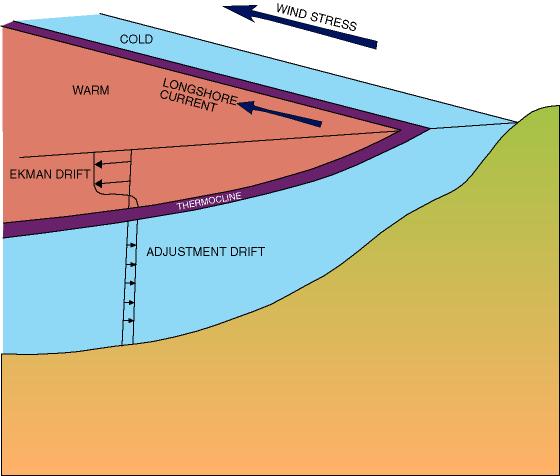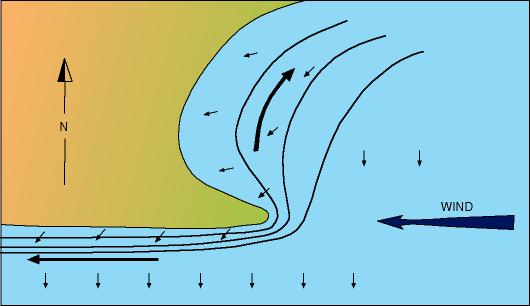Wind Driven Coastal Upwelling
Dowload the PDF of this lesson by clicking here
 |
Along the south coast of South Africa, wind driven coastal upwelling occurs. This process is not to the same extent as the West Coast upwelling. Easterly winds generate offshore Ekman transport in the upper layer (refer Figure 1). These winds are more common during summer. Where the offshore bathymetry is relatively abrupt, the upwelling process progresses right to the coast itself. The upwelling events generally occur over only a few days (Schumann, 1999). |
|
Figure 1 |
Pressure cells over the south coast of South Africa have the greatest influence on the winds. In summer, the Westerly Belt migrates southward and draws these pressure cells further south, resulting in mainly easterly winds. In winter the opposite occurs with the Westerly Belt and pressure cells migrating northwards. The Indian Ocean High pressure cell is less dominant in winter.
The wind driven coastal upwelling in this region is prevalent during summer and autumn, and is concentrated off prominent capes (such as Cape Recife, Cape St Francis and Cape Seal). The presence of an easterly wind does not guarantee upwelling, as other factors such as strength and duration of the wind also influence this process. If the wind is favourable then in the bays east of each cape, downwelling will occur (refer to Figure 2). The abrupt topography south of each cape causes the surface flow to be predominantly offshore, resulting in surface divergence and upwelling. A coastal jet develops south of each cape and as a consequence, the upwelling will progress westwards.
 |
|
|
Figure 2 |
CLASSIC PAPER
Schumann, E. H., Perrins, L. -A. and Hunter, I. T. (1982). Upwelling along the South Coast of the Cape Province, South Africa. South African Journal of Science, 78, 238-242.
Bibliography
- Schumann, E. H. (1999). Wind-driven mixed layer and coastal upwelling processes off the south coast of South Africa. Journal of Marine Research, 57, 671-691.
- Schumann, E. H. and Brink, K. H. (1990). Coastal-Trapped Waves off the Coast of South Africa: Generation, Propogation and Current Structures. Journal of Physical Oceanography, 20, 1206-1218.
- Walker, N. D. (1986). Satellite observations of the Agulhas Current and episodic upwelling south of Africa. Deep Sea Research Part A. Oceanographic Research Papers, 33 (8), 1083-1106.



